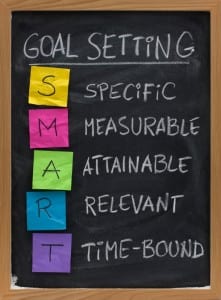Aiming to be “The Best” is a terrible goal for your brand.
We hear it often. Hell, we might even it say it often. “I want to be the best!” “My brand is the best!” But this is a major waste of our time and effort. And, I’m here to advise you against making this your goal.
Now you’re probably thinking “What? No way, Hilary! You should always try to be your best!”
Sure. Do everything you can to produce the best work you can. This is how we improve and become more skilled.
But, there is a problem when you work towards being able to say things like this for your brand:
- I am the best ________
- We make the best _______
- I sell the best ________
Or some popular veiled versions:
- We are the foremost leader of ____________
- Our company is the chief provider of _________
These sentences as an end-game may sound great, but simply don’t work. Here’s why:
S.M.A.R.T. Goals
We’ve all heard the phrase: S.M.A.R.T. goals! But do you know the meaning behind the popular acronym? It means that the goals you set are specific, measurable, attainable, relevant, and timely. Marketers know this phrase intimately. However, my experience has shown me that we don’t practice it intimately. We accept that S.M.A.R.T. is the responsible way to work towards success but we don’t practice it consistently.

I find that while mini-goals are more easily set as S.M.A.R.T. (i.e. get 1,000 new Twitter followers by the end of Q1), what most marketers fail at making are macro objectives. Macro objectives are the larger reasons for doing–the “whys”, if you will. Our “whys” get boiled into sweeping generalizations like being “the best” or a “front-lines leader”.
This isn’t smart nor S.M.A.R.T. What we think is an easy answer of “to become the best” really ends up hurting us in the end. It just doesn’t work to improve your company’s bottom line.
Let’s break down why using the S.M.A.R.T. acronym is the way to go:
The Best isn’t Specific:
Telling me you want to be the best leaves me with a question: The best at what? It doesn’t tell me anything about what you do or how your brand differentiates itself in your industry. It doesn’t tell me why you improve my experience over the other guys. It isn’t clear enough.

If I marketed for a candy company, being the best candy doesn’t communicate anything. What does the best candy mean to you? Ask 10 people and you’ll get 10 different answers.
Instead, ask “if I could only pick one thing to really excel at, what would it be? What do I want to be known for most?” Perhaps our fictitious candy company wants to be the most rebellious candy. Or in contrast, the most nostalgic. They might also consider being healthy, decadent, affordable, colorful… you get the picture.
Whatever it is, choose your single, most differentiating quality and work towards making that better for you. Have it become a part of your mission and values. Your customers will understand your benefit and your service will become better as well.
The Best isn’t Measurable:
How do you know when you’ve achieved “bestness”? You can’t. There is no measure for best because it is supremely subjective.
To solve this, use your differentiating quality from above and develop a strategy that can support your new mission fully. Choose an indicator or two that will really tell you whether you are fulfilling your promise. In our candy company example, perhaps they discovered that they really want to be the utmost luxurious, decadent confections treat. Where they obtain distribution (Neiman Marcus vs. 7-11) and their peak sales areas or times of year might be good measures.
The Best isn’t Attainable:
When I have been asked to complete to an objective that I know I can’t achieve, I get lost. I enter a Hulk-like emotional flight or fight syndrome. I either get so disengaged that I can’t produce anything or I fuss and fuss so much that I tear something great into pieces. It’s bad.

This is equally disastrous to a brand. An unattainable objective can make you abandon something that might be working that you haven’t noticed! Or might mess with your positioning so much that you alienate your existing fanbase by becoming too general and unfocused.
The Best isn’t Relevant:
When someone says they are the best at something, I usually think “So?” (I also don’t believe them.) Who cares if you’re the best? By whose standards?
Customers are smart. They know that saying you’re the “foremost leader” or “best in the world” is a myth. They also know that probably means you are hiding something and that doesn’t build trust.
With our candy company, working towards being the best candy only tells their customers what they think of themselves. The message isn’t good. This is not what true leaders do.

To avoid this, think about how you want to serve your consumers. Why do they turn to you? Where do you have expertise (or could develop) that could solve some problems your customers face? Keep in mind, specificity: you don’t have to solve everything for them. Just a small part of their lives that is relevant to them and your brand can close that gap.
The Best isn’t Timely:
Because the definition of what “the best” is will constantly change based on your consumer culture, there is no way that you can put an end date to see if you’ve achieved it.
Setting timeliness with larger objectives can be a challenge. Choose 2 or 3 KPI’s to measure your micro goals that support your larger objectives. If those stay on track, you can confidently know that you’re fulfilling your larger mission.
Get to Work!
Go through your old marketing work and see if you have any “the best” objectives and change them immediately! Let us know what you come up with below. We’re here to help at any step along the way.

Leave a Reply